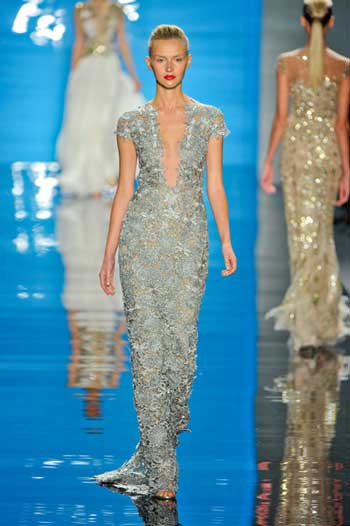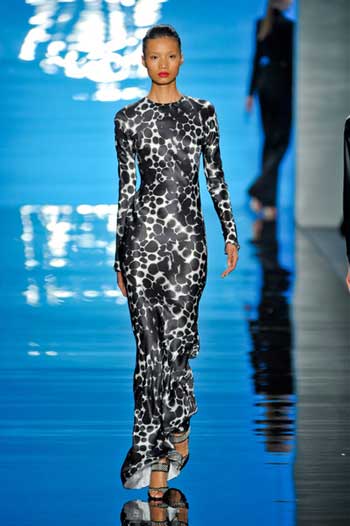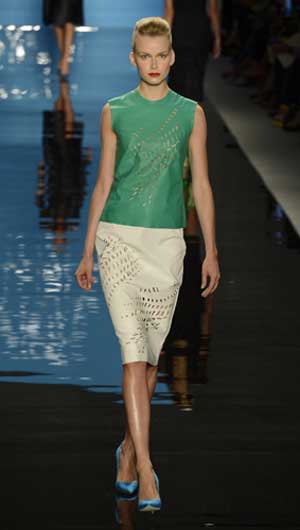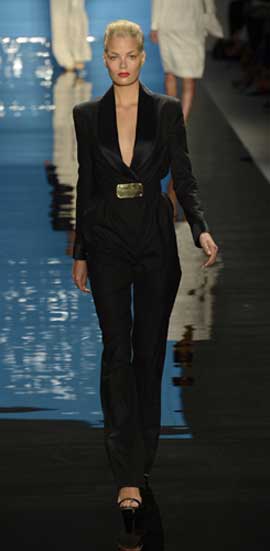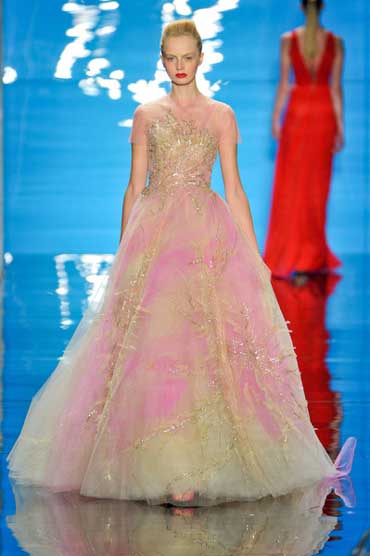Reem Acra Spring 2013 Show — Wearable Art Inspired By Aaron Young’s Paintings
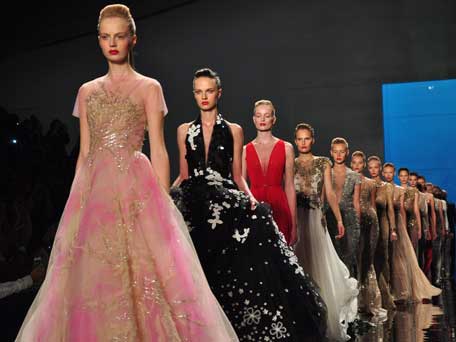
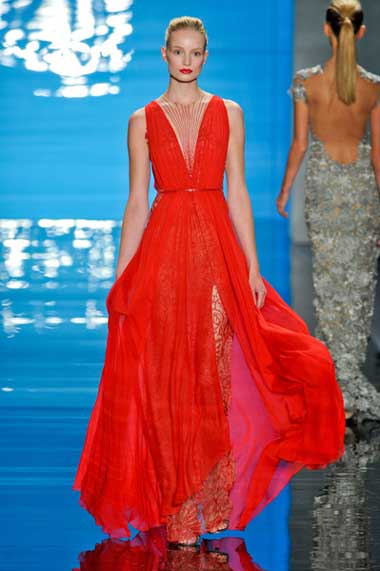
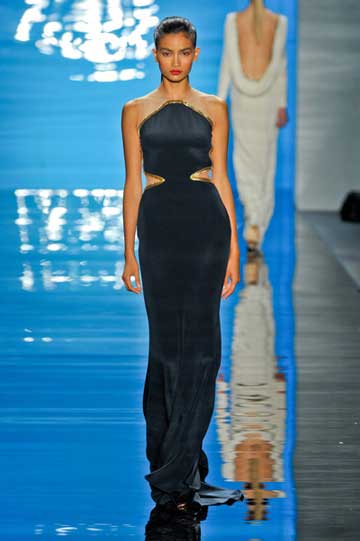

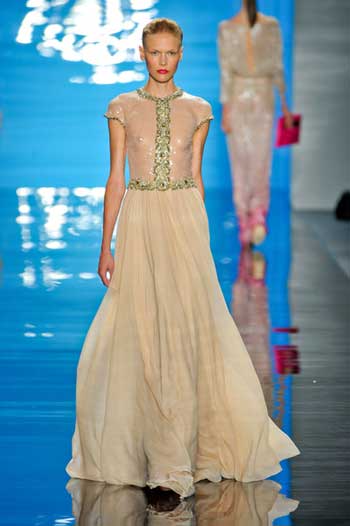
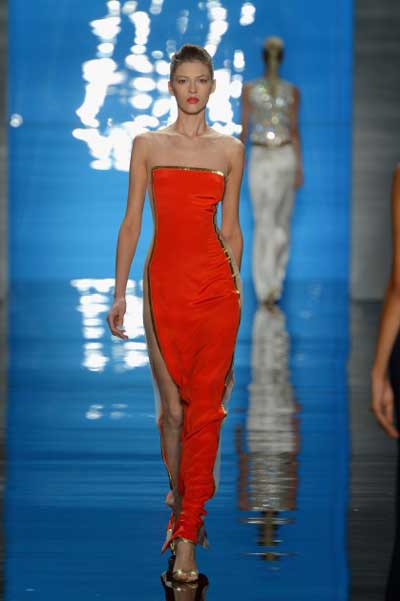
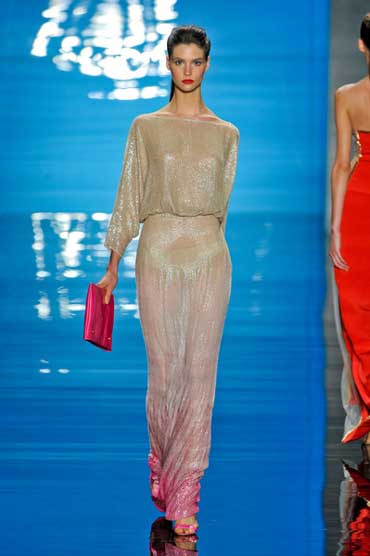
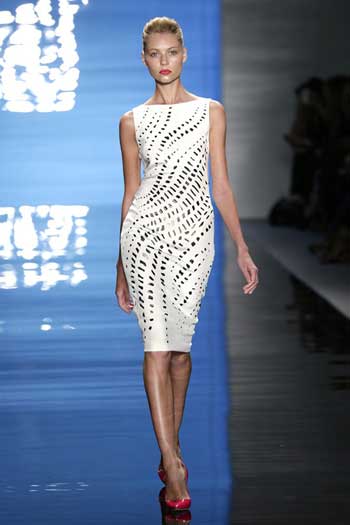
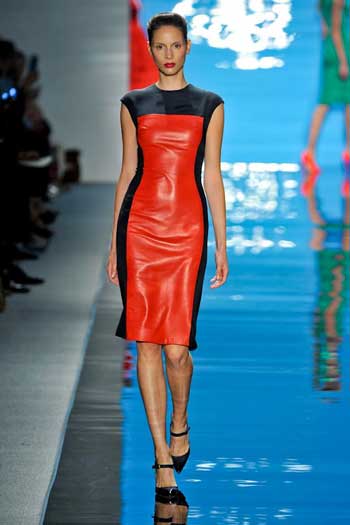
Jackson Pollock‘s influence on the work of San Francisco-bred artist Aaron Young extends beyond their shared interest in abstract shapes. Like Pollock, whose “drip paintings” made him an art world icon, Young approaches his medium as an extension of himself, interacting with his materials so that, in essence, he becomes a part of the work created. Pollock’s approach involved eschewing easels and, instead, tacking oversize, unstretched canvas onto the floor so that he could walk, crouch, kneel, and interact with the work, using his whole body to paint. Young’s process, meanwhile, involves more of a spectacle element — in fact, the motorcycle painting series that made him famous was created by covering an expansive area of the flow with plywood or aluminum, throwing layers of yellow, pink, orange, red, and black paint over the panels, then having a team of motorcycle riders rev their engines and glide over the surface area, their bike wheels creating elaborate swirls and swooshes. Each painting or sculpture Young creates, then, is a result of a choreographed live performance, a memento of that exhilarating moment when smoke and burnt rubber filled a room, tires screeched, headlights beamed, and kinetic energy filled the room with a chaotic intensity that translated into stunning works of abstract art.
Considering the elegance and sophistication we’ve come to associate with designer Reem Acra, her mention of Aaron Young’s work as an inspiration for her Spring 2013 collection came as quite the surprise. And yet the way in which Acra interpreted Young’s motorcycle paintings via fashion managed to ring true to her classic, red carpet-ready, refined aesthetic while channeling the undistilled, dynamo quality of the latter’s visual canon. On September 10th, when Reem Acra showcased her Spring 2013 collection in The Stage at Lincoln Center, she transformed the runway into an oil slick black color, the cyan blue lights emanating from the wings giving the surface a slick, almost wet-looking feel. As soon as the first model began stomping down the runway, the biker influence on the collection was immediately discernible as her sleeveless, body-hugging, knee-length, ivory silk crepe dress featured laser cut details meant to resemble motorcycle tread marks (as shown above, next to last). This tread mark laser-cut detail also appeared on slick separated like a green leather shell and ivory leather pencil skirt (as shown below), while leather bomber jackets and femme fatale leather dresses intensified the underlying rebel-with-a-stylish-edge feel. These pieces were then followed by similarly sharp, expertly tailored pieces like a fitted midnight navy silk crepe dress with a leather-like vermilion red insert at its center creating a color-blocked feel (as shown last above), along with a midnight navy pantsuit in a refined Dormeuil fabric that featured a tuxedo-like cut along the jacket collar.
As the attention shifted to evening dresses, the references to biker culture abated, and Acra evoked the spirit of Young’s work via both her choice of colors and the push-and-pull between chaos and control, destruction and creation evident in some of the pieces’ construction. A stunning, floor-length, midnight navy silk crepe dress, for instance, featured geometric cut-outs along the sides trimmed with gold beading, along with similarly gilded neckline in a mesa-like, gravity-defying shape (pictured third from top). Similarly, a strapless vermilion gown featured cut-out panels along either side, adding an unexpected sense of entropy to an otherwise clean and orderly silhouette, not to mention amping up the sensual energy exuded by the garment. An embroidered gold trim demarcated the bustline and framed the side cut-outs, bringing attention to these skin-revealing areas (as pictured above, fifth from top). A painterly theme was also explored via gowns with ink blot patterns (like the long-sleeved dress shown second below) and beaded pieces with ombré effects, the shimmering fabric moving from ivory and gold to blush pink and intense fuchsia (as with the slinky dress pictured above, seventh from top).
The final gowns, meanwhile, shifted away from specific references to Young’s work but, instead, focused on the notion of fashion as wearable art. A silver guipure lace dress (shown first below) looked like molten metal dripping from the models’ body, the materials’ floral patterns resembling a second skin on her figure, the plunging neckline adding a risqué but demure vibe. A show-stopping vermilion red dress featured billowing silk chiffon layered over a fitted, hand-embroidered, semi-sheer gown, so that as the chiffon skirt floated and danced in the move, the intricate patterns on the gown were visible, creating a sensation fo surprise with every new peek. The V-shaped neckline, meanwhile, incorporated a sheer fabric panel with starburst-like lines radiating outward like tulip blossom opening its petals (as shown above, second from jump). A vermilion and onyx ball gown with a halter neckline and a voluminous, princess-like skirt featuring layers of tulle underlay, meanwhile, dazzled with its scattered white floral appliqués and pailletes (shown above, fourth from top).
With every new look that made its way down the runway, there were gasps, “oohs and aahs,” frenetic photo-snapping, and excited mumbles exchanged by those in adjacent seats. In fact, at the show’s end, audience members stood to their feat and gave Reem Acra a standing ovation — a much-deserved sign of respect and reverence for a designer whose work prompts us to dream, to fantasize, and to remember why fashion is, above all, a form of artistic expression.
Check out all the photos above and below, and don’t miss the video of the models’ finale walk embedded above!
